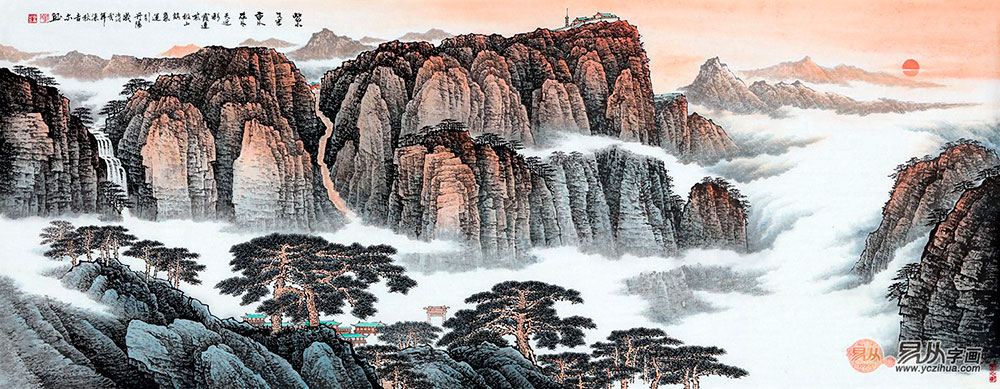Being the descendants of Yandi and Huangdi, we have seen many landscape paintings since childhood. A close examination can always reveal one nuance, regardless of whether the painting belongs to the conceptual style (“painting of ideas”) or the style of “diligent brush”, the style of salon painting or painting by unprofessional artists, but most landscape works are created from afar rather than at close range.
What does it mean “created from afar rather than at close range”?
This means that not a near, but a distant plan is shown. This interesting phenomenon attracts our attention. Therefore, today we will briefly consider why not a near, but a distant plan is shown in the Chinese landscapes.
In order to solve this issue, you must first understand what the term “distance” means.
The word “distance” has a double meaning. The first value is the range of physical space, and the second is the range of spiritual space. These two values penetrate each other, and together they create a tradition according to which the Chinese landscape painting is created by an artist who is situated relatively to the depicted in the background, and not in the near.
Free wandering
Chinese culture has shaped the unique aesthetic consciousness of the Chinese. Since the ancient times, the Chinese have loved to keep a distance in physical space and consider this “distance” a great and magnificent component of beauty.
In the Chuang Tzu. Free Wandering work it tells a mythical story filled with the power of imagination. A huge fish called Kun lives in the North Sea, and one day it suddenly turned into a huge Peng bird. Peng migrated south along with the sea current, she spread her huge wings and, using the wind, carrying blue sky and white clouds on her shoulders, flew over thousands of mountains and rivers and went to a distant and mysterious place. Through this mythical story, the author expressed the idea that people should have great aspirations, high impulses and set ambitious goals for themselves, overcoming endless expanses.
This passage fully expresses the desire of the Chinese people for a vast world. The Chinese perceive the vastness of physical space as beauty. This beauty is assimilated by them as a strong feeling and high aspiration.
In addition, Cao Cao has the famous poem View of the Blue Sea:
“Going east and climbing Mount Jieshi, I watched the boundless sea. The waters were restless, with islands towering right in the midst of the waves. Around lush trees, there are lush flowers and herbs. A cold autumn wind blew at the trees, making a sad whistle, and heaving giant waves on the sea. The rising and setting moon and the sun are as if born from this immense sea. And even the bright constellations of the Milky Way seem to be born from the arms of this sea. I was very happy and wrote this poem to convey my spiritual aspirations. “
This poem describes the magnificent landscapes that the lyrical hero saw, climbing a reef and looking from afar at the wide blue sea. As a rule, the Chinese perceive the aesthetic awareness of beauty through the distance of physical space. And landscape painting is created in the process of forming this aesthetic consciousness. Since its inception, landscape paintings have focused on the technique, which can be formulated as follows: “as if can be touched by the hand, but in fact the distance is like ten thousand li,” that is, as far as possible, the landscapes displayed a “distant plan” of the landscape on a limited sheet area in the physical space to satisfy the aesthetic taste and spiritual aspiration of the Chinese people.
An ancient temple in the deep mountains. Lu Heng
This landscape painting of the Lu school is full of spirituality; it depicts the height and range of the mountain space. The artist depicts circling clouds through a large extent of empty space, and the hills that rise far away give viewers the feeling that there are other mountains beyond the mountains, that is, they awaken in them a sense of the infinite. The ancient temple is hidden in picturesque mountains and forests and creates a mood of remoteness from the bustle of the world.
During the Song Dynasty, landscape painting took on the form of an established art. Guo Xi, an artist of the imperial court, wrote a book on the landscape painting theory entitled Linquan Gaozhi (Collection of notes on the high essence of forests and streams). In this book, he formulates the famous law of the “three distances”, that is, the law on the “high distances”, “deep distances” and “even distances” inherent in the landscape painting.
The so-called “high distances” refer to the view directed from the foot of the mountain to its top. When using this technique, the mountains in the picture should look tall and majestic.
The so-called “deep distances” are connected with the gaze, which is directed from the foothills and to what is behind the mountain, while the mountains in the picture look separate, in a deep and infinite space.
The term “even distances” means that the mountains are painted from a close plan and continue to the distant plan, and when painting the landscape, strict correspondence of the levels must be observed.
This “three distances” method embodies the desire of the Chinese people to the distance of physical space.

